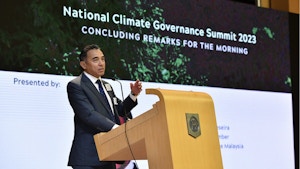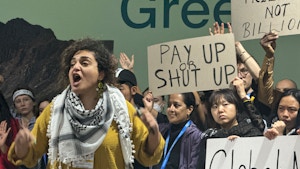A long and complex draft of the new climate fund goal marks the final days of the climate change intersessional conference in Bonn, ahead of the main United Nations Conference of Parties (COP) 29 set for the end of the year.
To continue reading, subscribe to Eco‑Business.
There's something for everyone. We offer a range of subscription plans.
- Access our stories and receive our Insights Weekly newsletter with the free EB Member plan.
- Unlock unlimited access to our content and archive with EB Circle.
- Publish your content with EB Premium.
A new and larger target, also known as the new collective quantified goal on climate finance (NCQG), is expected to displace the current US$100 billion pledge made by wealthy countries, which is due to expire in 2025.
The 65-page draft, which had been cut in half as of Monday, shows how much member parties feel is riding on the NCQG to be able to reach the long-term goals of the Paris Agreement, say observers present at the negotiations.
“Parties have expressed concern about the draft’s length and how unwieldy it is, with some stating outright that they cannot work with such a document,” said Niner Guiao, operations director, Parabukas, an Asia-based international consultancy for environmental laws and policies.
“The length and scope of the draft will definitely be a challenge when it comes to trying to achieve consensus, especially since it was determined at the previous meeting that the substance of the text could not really be discussed until the document is simplified.”
What is the NCQG?
When countries signed the Paris Agreement in 2015, they decided to set a “new collective quantified goal on climate finance” (NCQG) that is intended to be the successor to the existing goal of US$100 billion per year. The new finance goal is aimed at channeling additional funds toward urgently needed climate action in developing countries. It will support implementation of low-carbon, climate resilient solutions in energy, transport, agriculture among others.
Source: World Resources Institute
The length of draft texts on disputable topics like climate funding usually run at 10 to 20 pages long, said John Leo Algo, national coordinator of nonprofit network Aksyon Klima Pilipinas, who has been attending the UN climate talks intersessionals as an observer since 2017.
The length of the draft will make it even more difficult to finalise, said Algo, who added that climate finance has already been the most contentious issue in the history of the climate negotiations, besides phasing out fossil fuels.
However, he noted that having a long draft shows the “diversity of perspectives” that come with the involvement of nearly 200 member parties and thousands of observers contributing to the NCQG.
Climate negotiators come together annually in Bonn, Germany to prepare decisions to be adopted at the COPs. This year, COP29 is set to take place in Baku, Azerbaijan in November, while the Bonn climate talks are taking place from 3-13 June. The Bonn Climate Change Conference (SB60) is meant to be a more technical affair as it does not see the attendance of heads of states or fanfare of the event-packed pavilions at COP.
“
Parties have expressed concern about the draft’s length and how unwieldy it is, with some of them stating outright that they cannot work with such a document.
Niner Guiao, operations director, Parabukas
Show renewables ambition to secure climate finance
Developing countries that do not fall under the category of least developed country (LDC) or small island developing states (SIDS) will have to show more ambition in mitigation, which includes funding for renewable energy sources, if they want to secure climate finance, said Ana Mulio Alvarez, loss and damage researcher from London-based think tank E3G.
Under the current NCQG text, the recipients of funding are limited to “the poorest and most vulnerable, in particular LDCs and SIDS,” and to “the most ambitious countries who require support”. These countries do not include the likes of the Philippines, even if though it is a climate-vulnerable nation.

Robert Borje, vice-chariperson of the Philippine Climate Change Commission, leads a discussion in between sessions at Bonn, with fellow delegates Rachel Herrera and Jerome Ilagan of the Climate Change Commission, Dr Rosa Perez of the Manila Observatory, and Noralene Uy of the Department of Environment and Natural Resources. Image: Climate Change Commission
“Countries like the Philippines, which is not an LDC or SID, run the risk of being left out of the climate finance deal,” said Alvarez. “This means that Philippines and other countries like it may be left with receiving mostly semi or non-concessional loans or have to wait for the private sector to be mobilised and deliver, in both adaptation and mitigation efforts.”
The Philippines has been working towards increasing the share of renewables in its energy mix to 35 per cent by 2030, along with incentivising foreign direct investment on clean energy projects. However, it is set to become one of the leading buyers of liquified natural gas, together with Vietnam as both countries began importing methane gas in 2023.
“Rather than entertaining more fossil-based and fossil-friendly technologies which developing nations continue to pour money into, our government must focus on unlocking the Philippines’ massive renewable energy potential,” said Gerry Arances, convenor of Power for People Coalition (P4P), a network of civil society organisations, communities and cooperatives that rally against pollutive fuels.
“Representatives of the Philippines and other vulnerable countries need to champion securing finance to implement our adaptation plans, with heavy emphasis on building the resilience of communities and strengthening nature-based solutions.”














